Physical Address
304 North Cardinal St.
Dorchester Center, MA 02124
Physical Address
304 North Cardinal St.
Dorchester Center, MA 02124

Sarah, a multigenerational home designer, shares 23 practical tips for a modern kitchen that blends harmony, cultural needs, and timeless style for the whole family.
You know what people always ask me? They show me a photo of a super sleek, stark white kitchen and say, “I want this.” But after we talk for a bit, what they really want is a space that can handle the beautiful, messy reality of family life. They want a kitchen where grandma can teach the kids her secret family recipes, where teenagers can descend like a horde of locusts for after-school snacks, and where you can have a quiet cup of coffee before the house wakes up.
A truly “modern” kitchen isn’t about chasing a trend you saw in a magazine. It’s about creating a space that breathes with your family. It’s about blending different needs, habits, and even cultural traditions into a room that feels calm, works effortlessly, and makes everyone feel like they belong. It’s the heart of the home, and that heart needs to be big enough for everyone.
This is the most important part, and it’s where most people go wrong. They start by picking out tile. No. You have to start with the “why.” Why are you changing things? Who is this space for? Thinking about this first saves you so much heartache—and money—down the line. This is where we create the blueprint for a room that doesn’t just look good, but feels good.
Can we talk about why everyone gets minimalism wrong? It is not about having an empty, sterile white box for a kitchen. True minimalism, especially in a family home, is about reducing visual noise so your brain can relax. For the parent juggling a job, kids’ homework, and caring for an aging parent, a cluttered countertop is just one more thing demanding your attention. It’s mental exhaustion made visible.
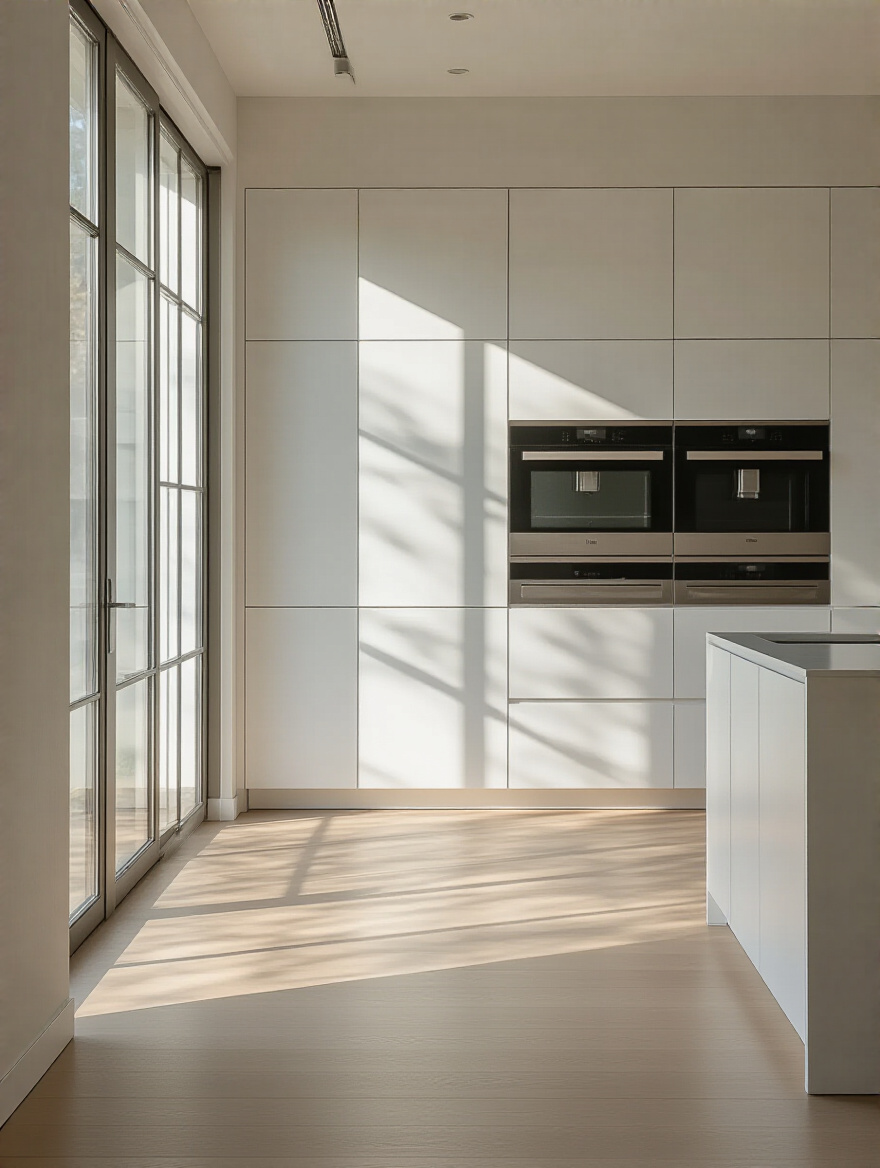
A minimalist approach is about being incredibly intentional. It means everything has a home, and that home is easy to get to. I once worked with a family whose kitchen was the source of constant tension. No one could find anything, and the clutter was overwhelming. By creating dedicated zones and ruthless decluttering, we didn’t just make it look better; we literally lowered the stress level in the home. It’s about creating calm, not coldness.
Once you’ve cleared the mental and physical space, you can start thinking about how that space is laid out for the people moving through it every day.
Everyone says they want an “open-concept” kitchen, but just knocking down a wall often creates a new set of problems. Suddenly, the cooking smells are in your sofa, the sound of the blender is interrupting a Zoom call in the living room, and there’s absolutely no-one-can-see-this-mess zone. A successful open layout isn’t about having one giant, undefined room; it’s about creating smart “zones” that flow into one another.
You have to think about how your family actually lives. In many homes I design, especially for families with strong culinary traditions from South or East Asia, a full open-concept kitchen is a nightmare. The aromas from frying spices or a high-heat wok are wonderful, but they don’t belong on your curtains. In these cases, we might design a main “show” kitchen that’s open and social, plus a smaller, hardworking “spice kitchen” with powerful ventilation that can be closed off. It’s the best of both worlds: you get the connection without sacrificing practicality.
And that sense of connection is supported by the visual language you choose, which almost always starts with color.
Okay, here’s the truth: a neutral palette is the easiest way to make a space feel bigger, brighter, and calmer. It’s a fact. Light colors bounce light around and create a serene backdrop. But this does not mean your kitchen has to be boring or devoid of personality. Think of neutrals—your whites, soft grays, warm beiges—as the canvas, not the entire painting.

In many cultures, color is deeply meaningful. For a Chinese family, touches of red can signify luck and happiness. For a family from Latin America, vibrant tiles might feel like home. The key is to use that neutral foundation of your cabinets and walls, and then layer in that color and personality in ways that are flexible. Bring in color with your backsplash, with a beautiful piece of art, with the bar stools, or with a display of handmade pottery. A neutral base gives you the freedom to celebrate your heritage without overwhelming the space.
This idea of a clean, uninterrupted canvas is perfectly complemented by the cabinetry you choose.
This might seem like a purely aesthetic choice, but it’s one of my favorite shortcuts to a truly functional family kitchen. Handle-less cabinets are a triple win. First, yes, they create those long, clean, uninterrupted lines that make a space feel expansive and uncluttered. It’s a visual trick that really works.
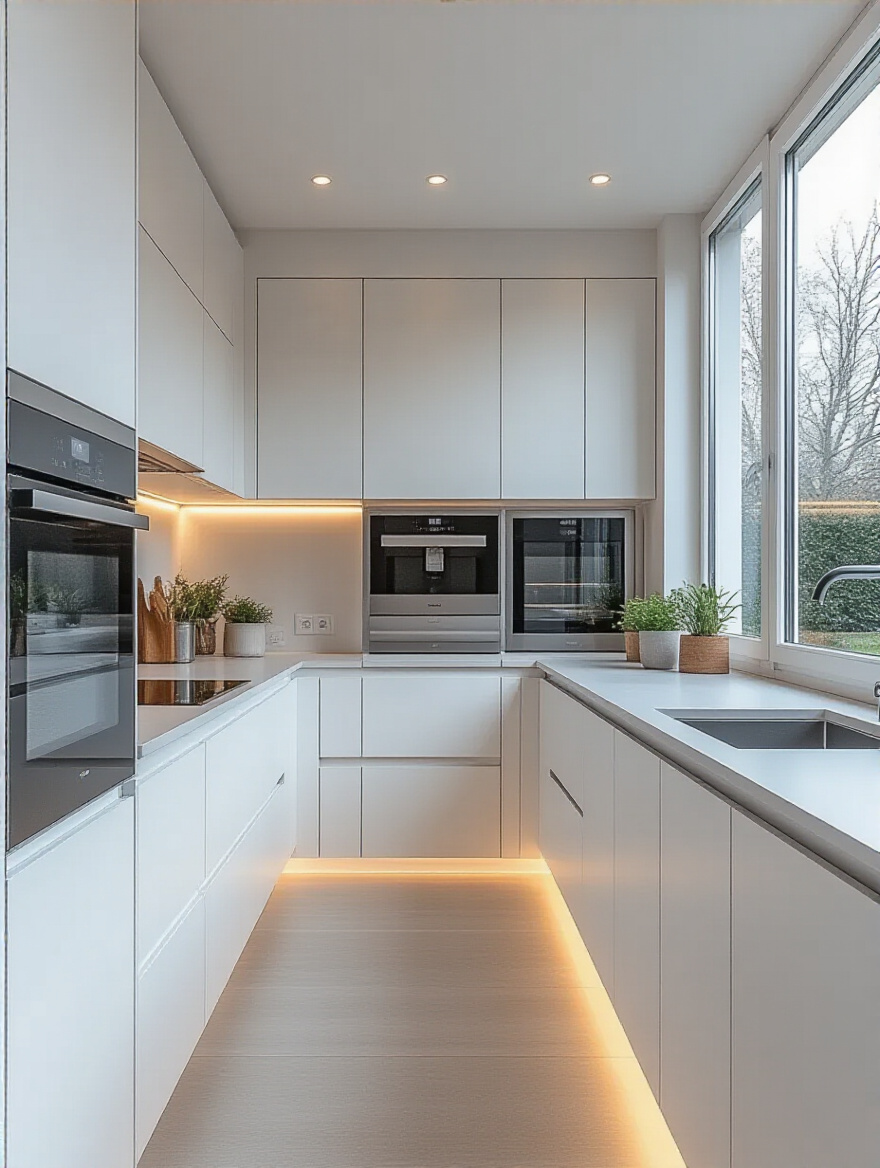
But the practical benefits are what I love most. There are no handles for a running toddler to bump their head on. For older adults who might be a bit unsteady, there’s nothing to catch a sleeve or a hip on. And for the person who cleans the kitchen? It’s a dream. You just wipe down a flat surface. No trying to get grime out from around the base of 30 different knobs and pulls. It’s a small detail that simplifies life in a noticeable way.
The simplicity of the cabinet fronts puts even more focus on how the whole room is organized.
The classic “kitchen work triangle”—the path between the sink, stove, and fridge—is hopelessly outdated for most families today. Life isn’t that simple. You have multiple people doing different things at once. We need to think in terms of “work zones.” The goal is to allow for both independent tasks and collaboration, without everyone tripping over each other.
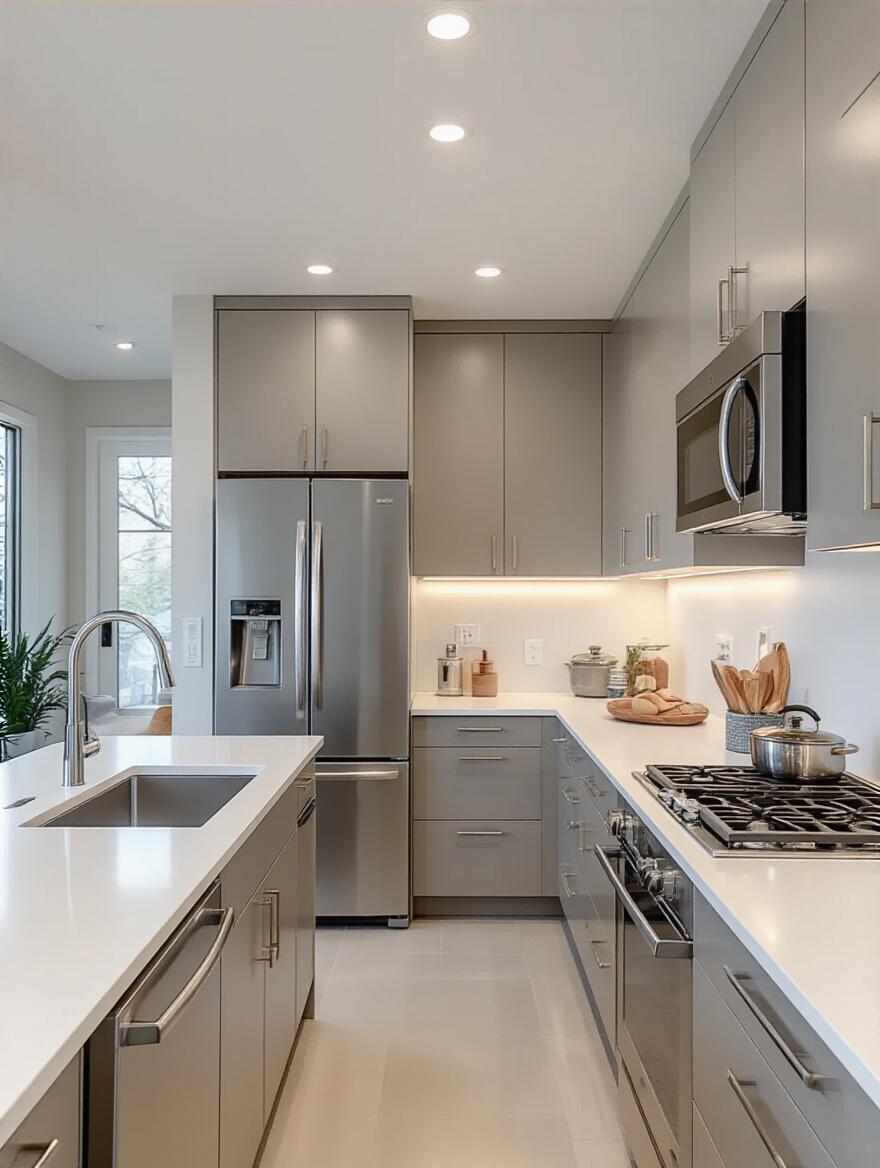
For a family I worked with recently, we designed a layout with four distinct zones. The main cooking zone had the big range and pot-filler. Then we created a separate baking station with a lower countertop—perfect for kneading dough and easy for the kids to help with—and its own sink. There was a beverage and snack station near the fridge, so the kids could get their own drinks and snacks without entering the main cooking area. And finally, the island was for cleanup and homework. By giving everyone their own space, we created harmony out of potential chaos.
A wise designer once told me, “A good layout doesn’t just look good, it feels like a dance. Every move is intuitive and graceful.”
Once your layout feels right, we can get to the fun part: the materials. These are the things you’ll touch and see and use every single day. They need to be beautiful, yes, but more importantly, they need to be tough enough to handle your family’s real life. This isn’t a showroom; it’s a workshop for life.
Your countertop is your primary work surface, so it has to be a workhorse. For most families, I steer them toward quartz. It’s engineered to be non-porous, which means you don’t have to worry about spilled wine, soy sauce, or—the ultimate test—turmeric staining it. You can just wipe it clean. There’s no need to seal it every year, which is a gift to any busy homeowner.
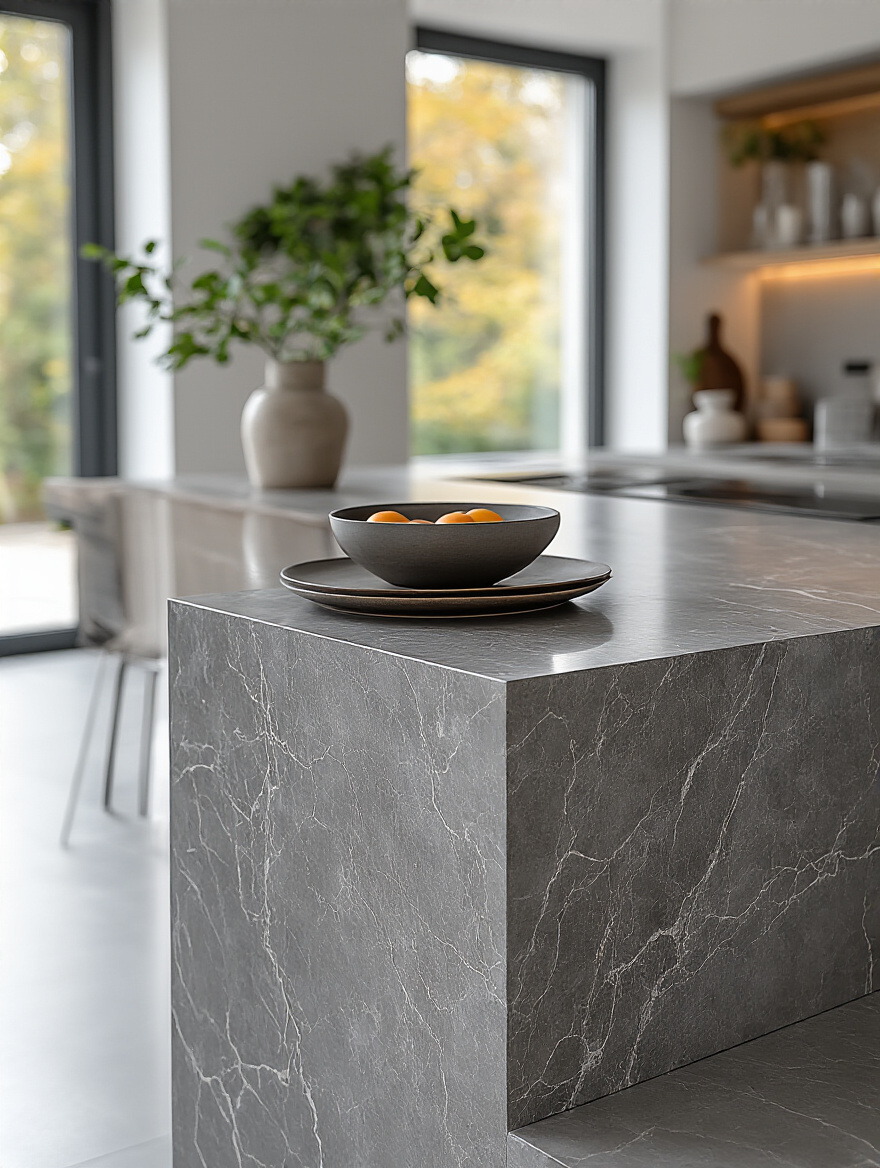
Concrete is another fantastic option for its durability and unique, industrial vibe. However, be aware that it needs to be sealed properly to prevent it from absorbing stains. The beauty of both these materials is that they offer a consistent, clean look that can anchor the entire kitchen. I designed a kitchen for an Indian family who did a lot of high-heat cooking and used vibrant spices. The cool, uniform grey quartz we chose was the perfect, indestructible backdrop for their culinary art.
Those workhorse countertops need to be supported by cabinets that are just as smart and durable.
Here’s a shortcut I wish I’d known earlier: for a home with kids or lots of hands-on cooking, a high-quality matte finish on your cabinets is a lifesaver. While high-gloss cabinets look stunning in photos and can bounce light around, they show every single fingerprint. Every. Single. One. It can be a full-time job just keeping them clean.
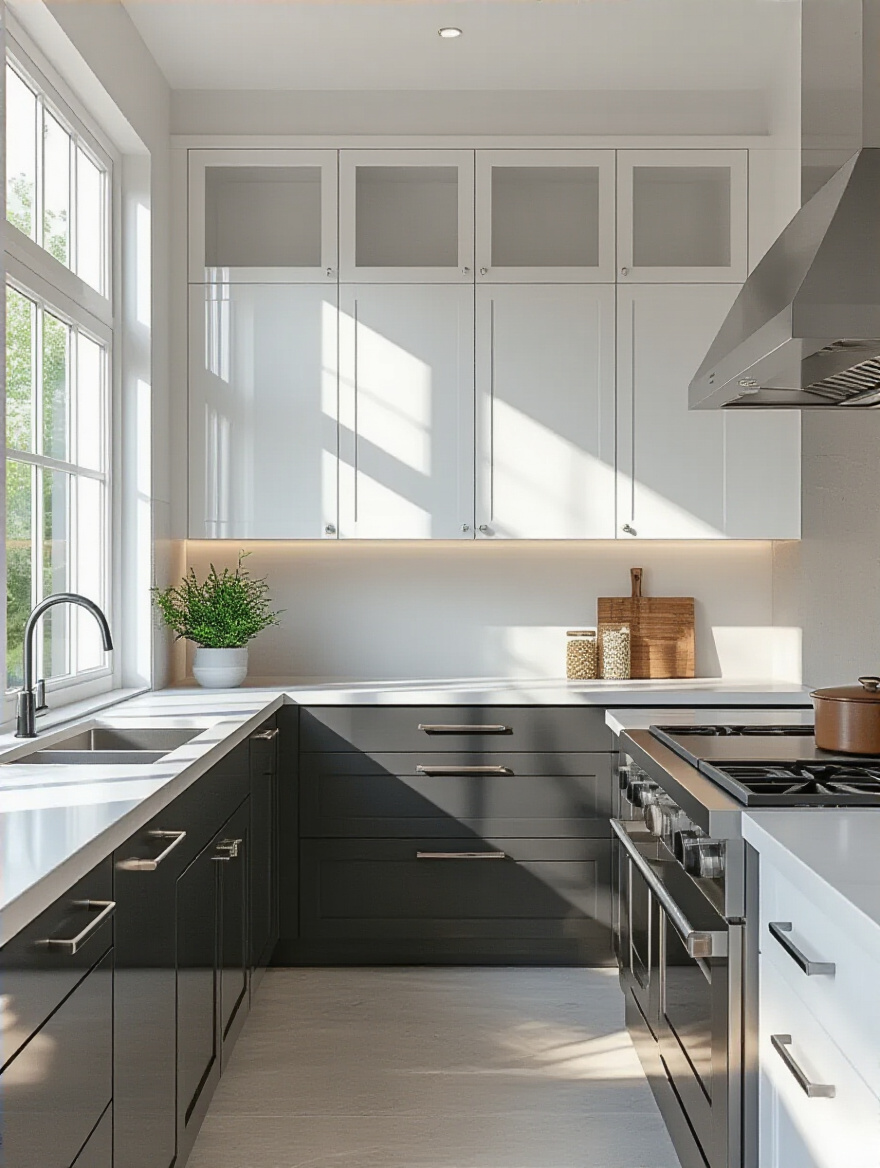
Super-matte finishes, on the other hand, are designed to diffuse light and resist smudges. They have this wonderfully soft, velvety feel and give the kitchen a very sophisticated, grounded look. A great trick is to mix and match. You can use a more durable, fingerprint-resistant matte finish on the lower cabinets and island—the high-traffic zones—and then use a beautiful high-gloss or wood finish on the upper cabinets to reflect light and add a bit of sparkle.
And what goes between those upper and lower cabinets? That’s where you can make a huge impact.
This is one of my favorite pro tips for an instantly high-end look that is also incredibly practical. Instead of using tiles for your backsplash, run the same slab material you used for your countertop right up the wall. It’s called a slab or seamless backsplash, and it is a game-changer.
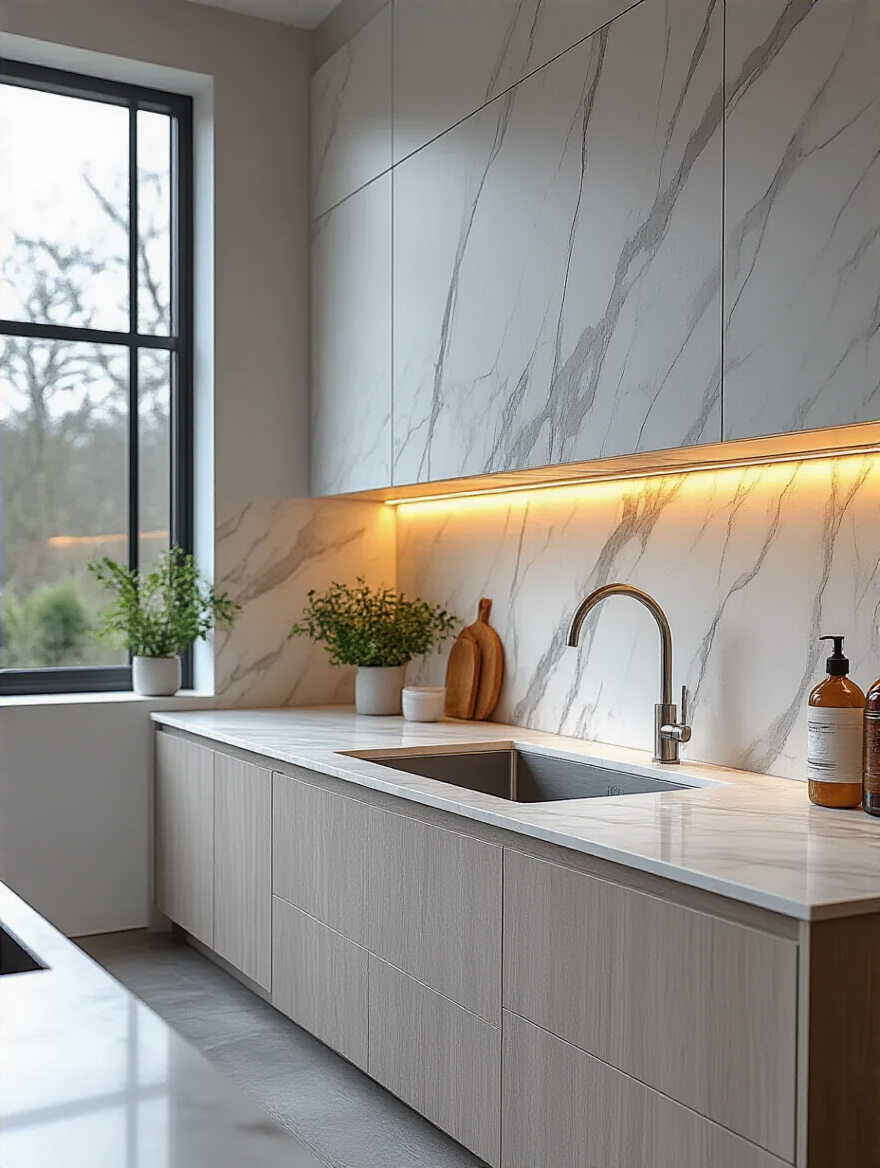
The visual impact is stunning—it creates a clean, monolithic look that feels incredibly chic and intentional. But the real win is the cleaning. There are no grout lines. Zero. Anyone who has ever tried to scrub tomato sauce or oil splatter out of grout knows what a victory this is. It completely eliminates one of the most annoying kitchen cleaning jobs. It’s the ultimate blend of beauty and brainpower.
That seamless look can be carried through to one of the most visible elements in the kitchen: your appliances.
I used to think panel-ready appliances that hide behind cabinet fronts were just for ultra-luxe, show-off kitchens. I was wrong. In a multigenerational or open-concept home, creating a calm and cohesive visual field is so important for everyone’s sanity. When you have a big block of stainless steel here, and a black glass oven there, it can start to feel visually chaotic.
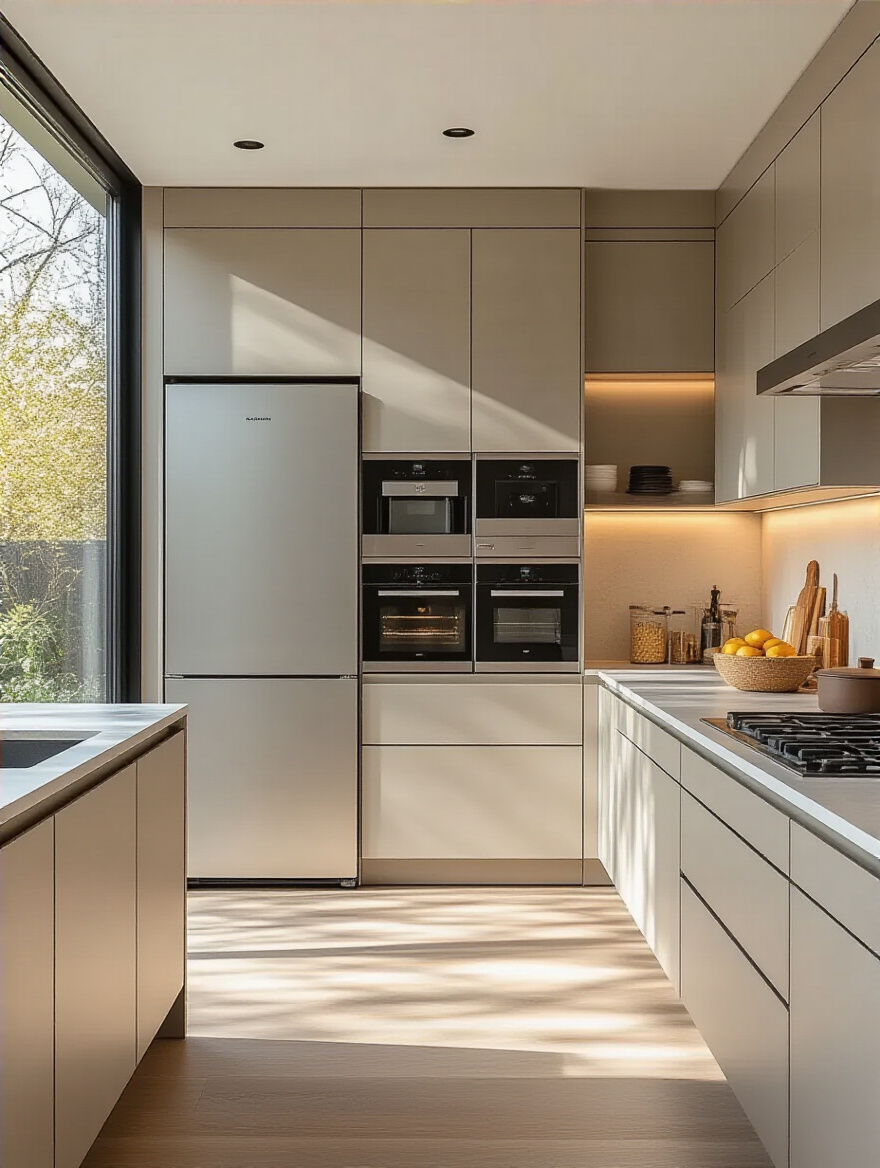
Integrating your refrigerator and dishwasher so they just look like part of the cabinetry makes the whole space breathe. It quiets the room down and allows the beautiful materials of your cabinets and countertops to be the star. It’s a bigger investment upfront, but it pays off every single day by contributing to a feeling of seamlessness and calm—something every busy family can use more of.
This idea of a seamless plane extends all the way down to the floor.
This follows the same logic as the seamless backsplash: less grout is more. Large-format tiles—think big squares or rectangles, like 24×24 or 24×48 inches—create a much more expansive and continuous-looking floor. Your eye isn’t constantly interrupted by a grid of grout lines, so the room automatically feels bigger and cleaner.
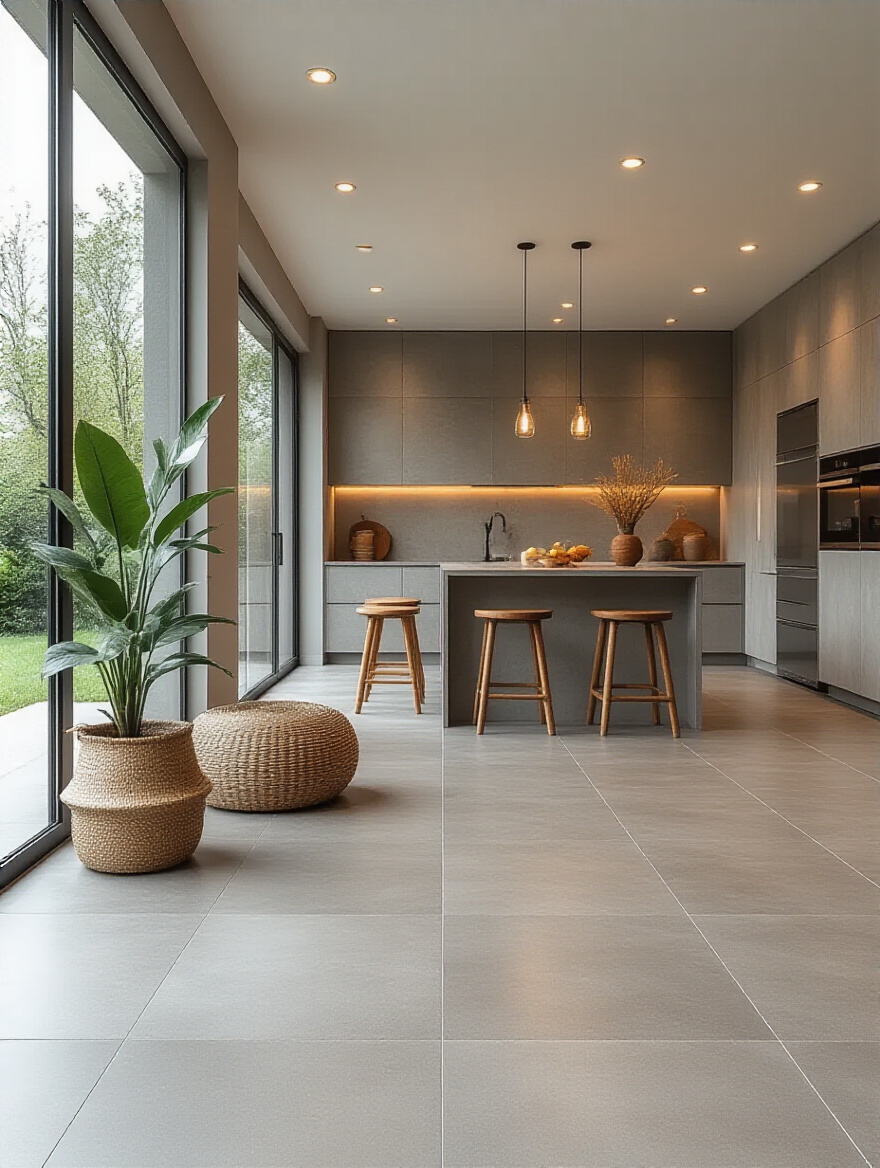
From a practical standpoint, it’s another win for easy maintenance. Less grout means fewer places for dirt and grime to get trapped. And from a universal design perspective, a smooth floor with minimal grout lines is easier for someone using a walker or wheelchair to navigate. It’s one of those simple choices that improves the look, the feel, and the function of the room all at once.
With all these smooth, clean surfaces, the little details, like your faucet, suddenly have a huge impact.
The faucet is the jewelry of the sink, and it’s a place where you can add a touch of sculpture and personality. A beautiful, minimalist faucet in a striking finish—like matte black or brushed gold—can act as a stunning focal point against a simple countertop and backsplash. It’s an easy way to elevate the whole look of the kitchen without a huge expense.
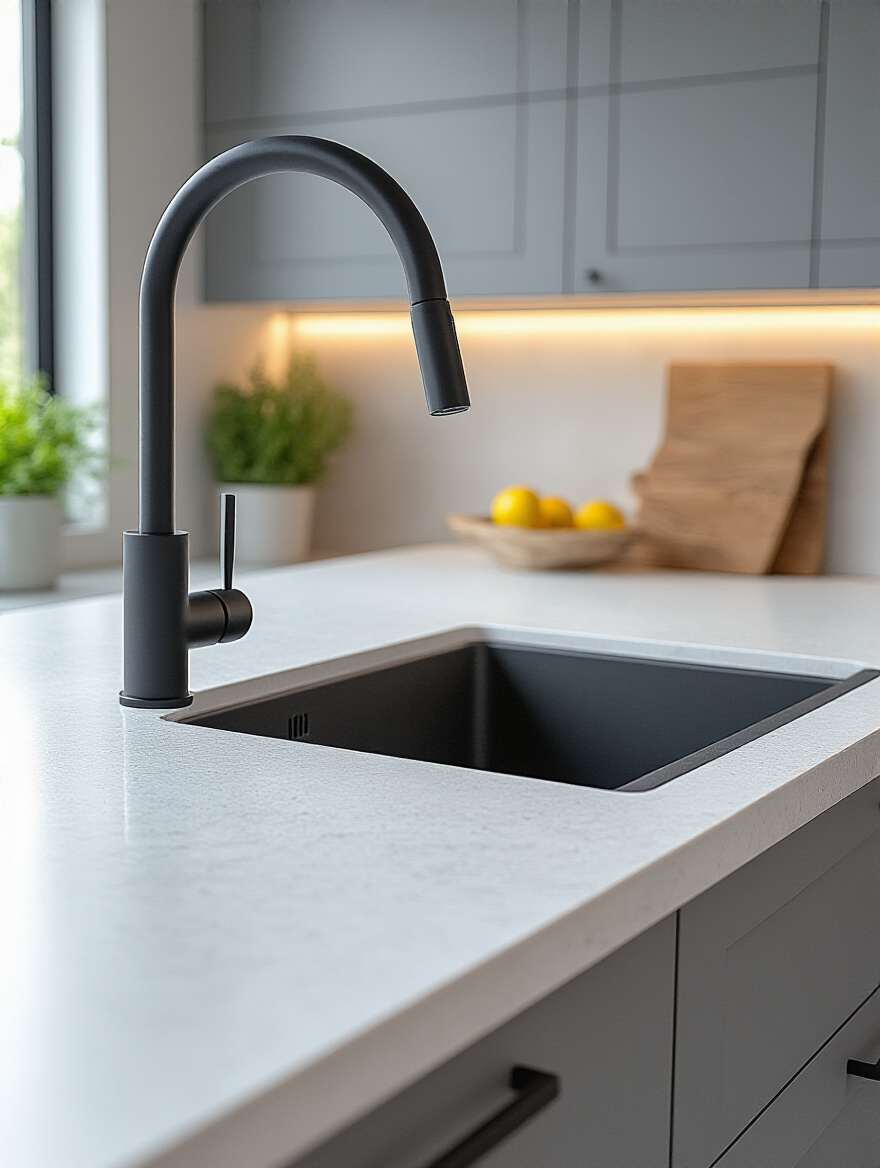
But again, think function first. I am a huge advocate for touchless faucets in a family kitchen. When you’ve been handling raw chicken, the last thing you want to do is touch the faucet handle. A simple wave of the hand to turn the water on and off is more hygienic. It’s also a fantastic feature for family members with arthritis or limited hand strength who may find it difficult to grip and turn a traditional handle.
Finally, none of these beautiful materials matter if you can’t see them properly.
Natural light is not a luxury; it is a necessity for a healthy and happy home. It’s the single most powerful design element you have. It makes spaces feel bigger, reveals the true color and texture of your materials, and has a proven positive effect on our mood and well-being. If there is any way to bring more natural light into your kitchen, do it.
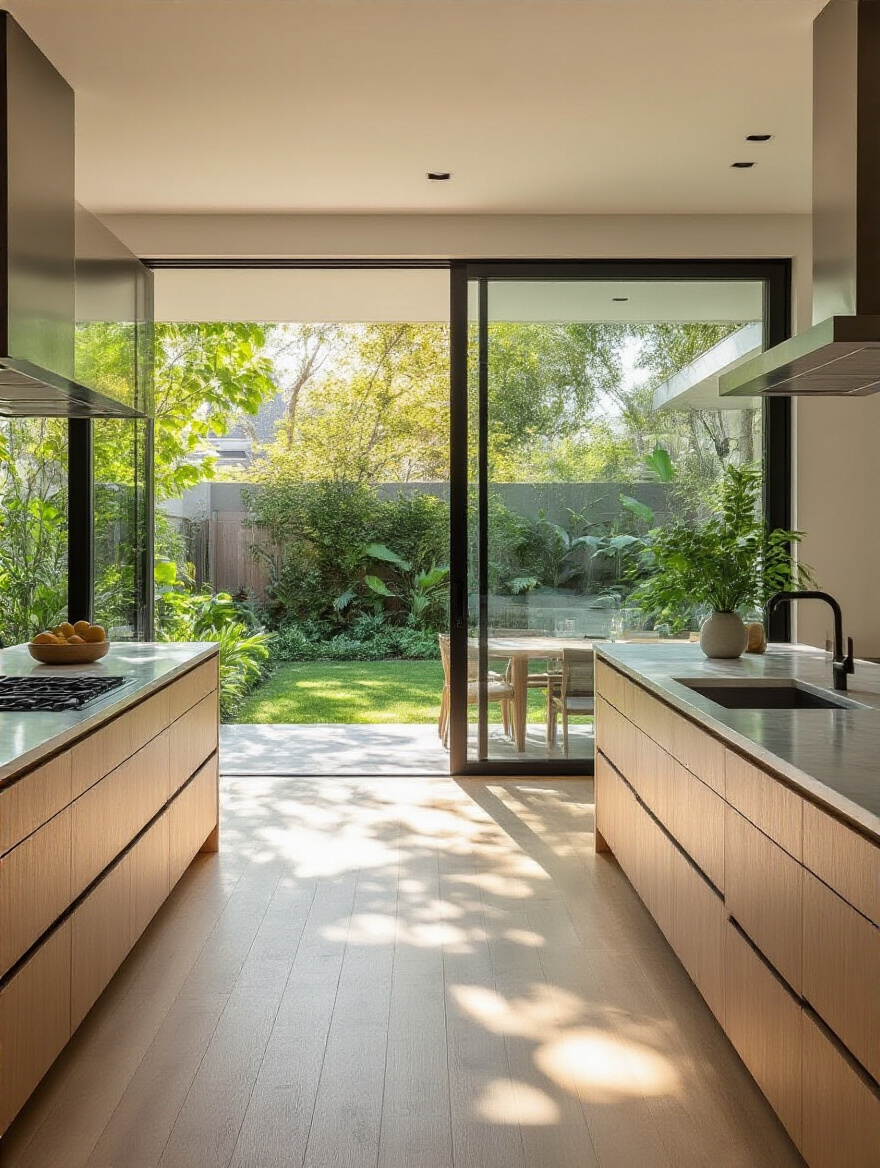
Whether it’s enlarging an existing window, adding a skylight or a sun tube, or replacing a solid back door with a glass one, connecting your kitchen to the outdoors will transform how it feels. For a family I worked with, we installed a large set of folding glass doors that opened the kitchen up to their small patio. It didn’t just flood the room with light; it effectively doubled their entertaining space and became the heart of every family gathering.
This is where the magic happens. Great lighting and smart technology can make a kitchen feel alive, intuitive, and responsive to your needs. This isn’t about flashy gadgets for the sake of it; it’s about using technology to make life simpler, safer, and more beautiful.
One single light fixture in the middle of the ceiling is a recipe for a dreary, inefficient kitchen. A great lighting plan has three layers. First is Ambient light: the overall, general light from recessed cans or a central fixture that lets you see where you’re going. Second is Task light: bright, focused light exactly where you need it for work, like under cabinets and over the island. Third is Accent light: soft, decorative light that adds mood, like lights inside a glass-front cabinet or a sculptural pendant.
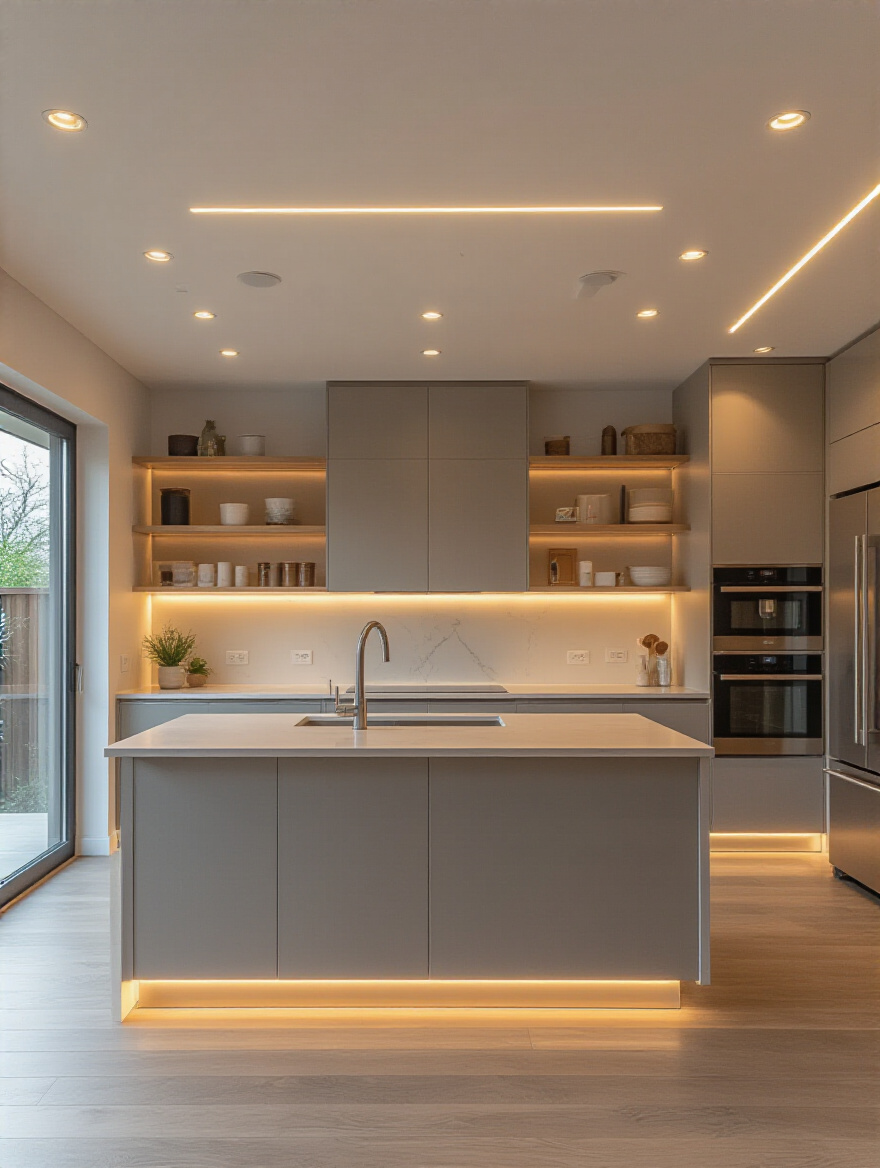
For a multigenerational family, this is essential. An older parent may need much brighter, shadow-free task lighting for chopping vegetables safely. But later, for a quiet family dinner, you want to be able to dim those task lights and turn up the warm, ambient glow. Layered lighting, all on dimmers, gives you the flexibility to create the right mood and the right function for any situation.
One of those layers is so important that it deserves its own moment.
If you do only one thing to upgrade your kitchen lighting, this is it. Under-cabinet lighting is non-negotiable in a modern kitchen. It puts bright, direct light onto your countertops, completely eliminating the shadows your own body casts from overhead lights. This makes food prep safer, easier, and less straining on your eyes.
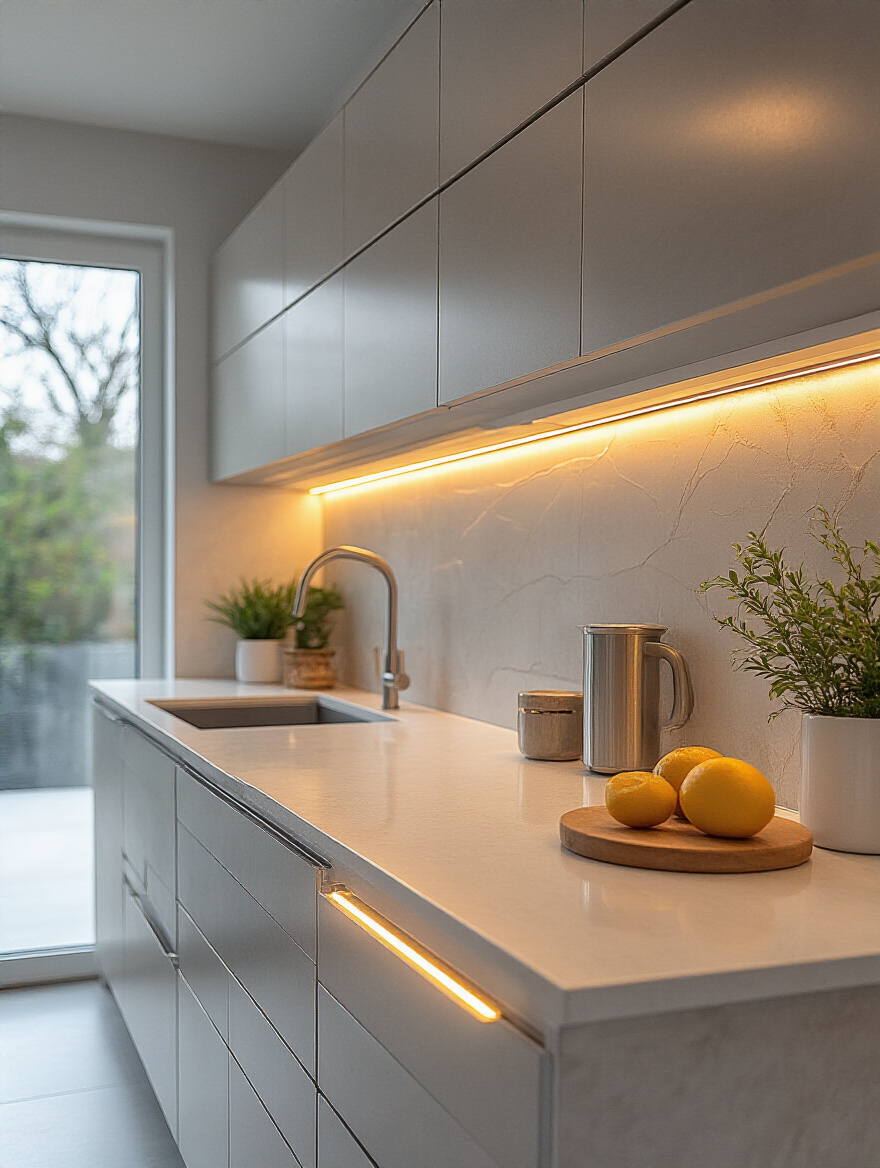
This isn’t just about function; it creates a beautiful effect. At night, you can leave just the under-cabinet lights on for a soft, gentle glow that makes the kitchen feel warm and inviting. It highlights your beautiful backsplash and countertop material and makes the whole space feel more polished and professionally designed. It’s the hardest-working light in your kitchen.
Beyond the workhorses, lighting can also be a chance to have some fun.
The island is often the social hub of the kitchen, and a beautiful set of pendant lights above it acts like an exclamation point. This is your chance to add a piece of functional art to the room. A sculptural pendant or a series of them can define the island area, add personality, and tie the whole design together.
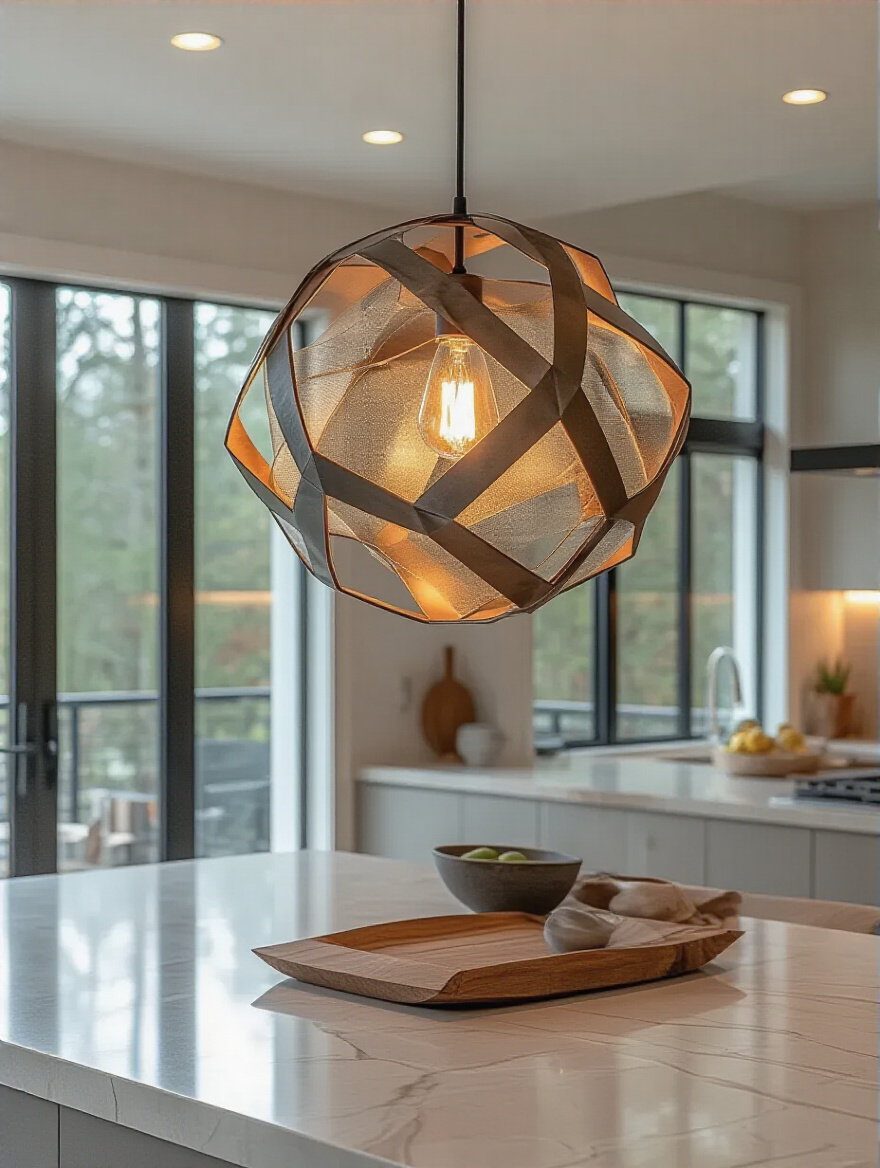
A word of caution for open-concept spaces: make sure the pendants don’t block important sightlines. You want to be able to stand at the sink and still see the kids playing in the living room or talk to a family member sitting on the sofa. Choose fixtures that are visually interesting but not so solid or low-hanging that they create a wall where you want an open view. Always put them on a dimmer so you can control the mood.
Modern kitchens aren’t just well-lit; they’re also getting smarter.
I was skeptical about smart appliances at first, but now I see how they can genuinely make family life easier. It’s not about having a refrigerator that talks to you. It’s about practical features that save you time and mental energy. It’s about an oven you can preheat on your way home from soccer practice so dinner is on the table faster.

For an older parent living at home, a smart cooktop that automatically turns off if a pot is left unattended can be a critical safety feature. A smart fridge that can show you its contents on an app while you’re at the grocery store helps reduce food waste. The key is to find technology that solves a real problem for your family, rather than just adding complexity.
The best technology, like the best design, is often the kind you don’t even notice.
Nothing chops up a beautiful, seamless backsplash like a row of white plastic outlets. Hiding them is one of those subtle, high-impact details that makes a kitchen look incredibly custom and clean. There are so many clever ways to do this now.

You can have outlet strips tucked up under the cabinets, pop-up outlets that recess into the countertop, or even have outlets installed inside a drawer to create a hidden charging station for all the family’s devices. This keeps your countertops free of cord clutter and allows the beauty of your tile or slab backsplash to shine without interruption. It’s safer, too, keeping electrical points away from accidental splashes.
Your kitchen is planned, built, and lit. Now, we make it yours. This is the final layer, where we add warmth, personality, and the story of your family. This is what turns a well-designed house into a beloved home.
Open shelving can be intimidating. People worry it will always look messy. The secret is to not think of it as “storage,” but as a “display.” It’s not for the mismatched Tupperware. It’s for the everyday items that are also beautiful, or for a few objects that hold special meaning for your family.

This is the perfect place for a set of bowls you use every day, a stack of your favorite cookbooks, or the ceramic mugs your kids made in art class. In a home I designed for a Japanese-American family, we used a single oak shelf to display a collection of beautiful, rustic tea cups that they used for their daily tea ritual. It was functional, personal, and brought a sense of serene tradition into their very modern kitchen.
Those cherished objects are often made from materials that connect us to the earth.
A kitchen full of hard, sleek surfaces can feel cold and clinical. The antidote is texture. Bringing in natural materials like wood, stone, linen, or woven fibers is the fastest way to add warmth and soul to the space. You don’t need a lot to make a difference.
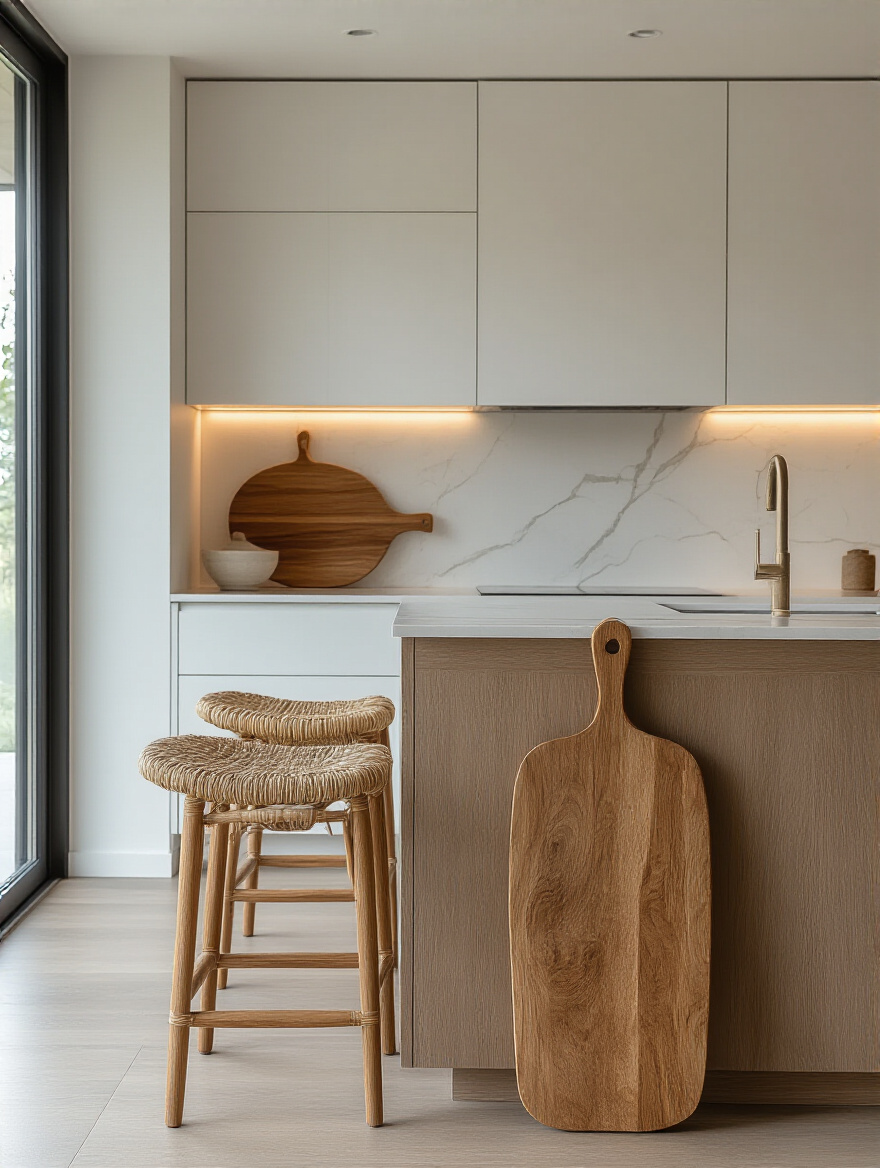
It can be as simple as a chunky wooden cutting board leaning against the backsplash, a set of bar stools with woven rush seats, or a beautiful linen tea towel hanging from the oven. These little touches break up the monotony of the smooth surfaces and make the room feel more tactile and inviting. They ground the space and give your eyes a soft place to land.
The ultimate natural accent, of course, is something living.
Even the most minimalist or industrial kitchen comes to life with a bit of green. Plants literally breathe life into a space. They soften hard edges, add a pop of organic color, and connect us to the natural world.
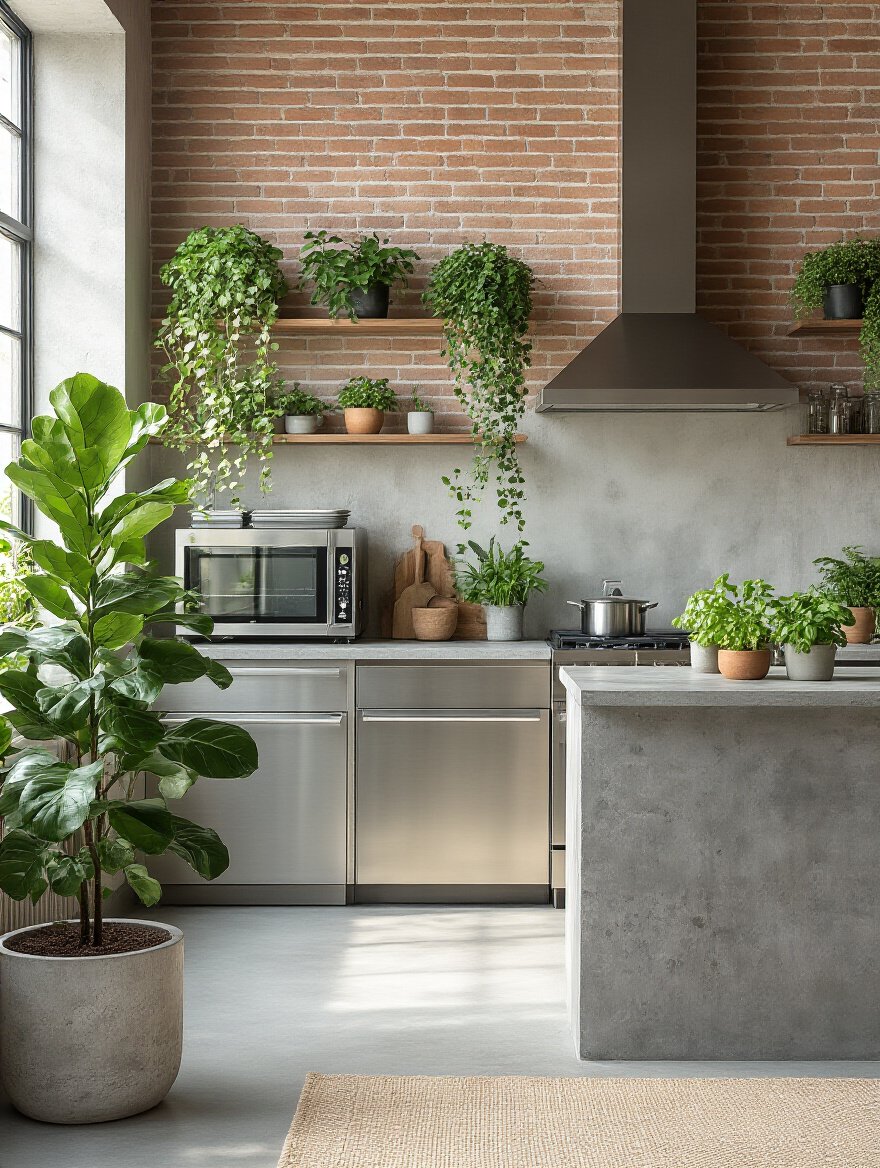
You don’t need a jungle. A small pot of herbs on the windowsill that you can snip for cooking is both beautiful and functional. A trailing Pothos on top of the cabinets or a tough-as-nails Snake Plant in a corner is all it takes. For one client with a very sleek, concrete-and-steel kitchen, we built a small vertical garden for herbs and lettuces right on the wall. It became a living piece of art and a source of incredible pride for the whole family.
Of course, the only way to keep a kitchen looking this serene is to have a secret weapon.
This is the secret to a perpetually clean-looking kitchen: having a designated, easy-to-access home for everything. Clutter happens when items don’t have a place to land. My favorite solution is the “appliance garage,” a section of cabinetry with a retractable door that sits on the countertop. Behind it, you can hide the toaster, coffee maker, and blender. You use them, then close the door, and the clutter is gone.
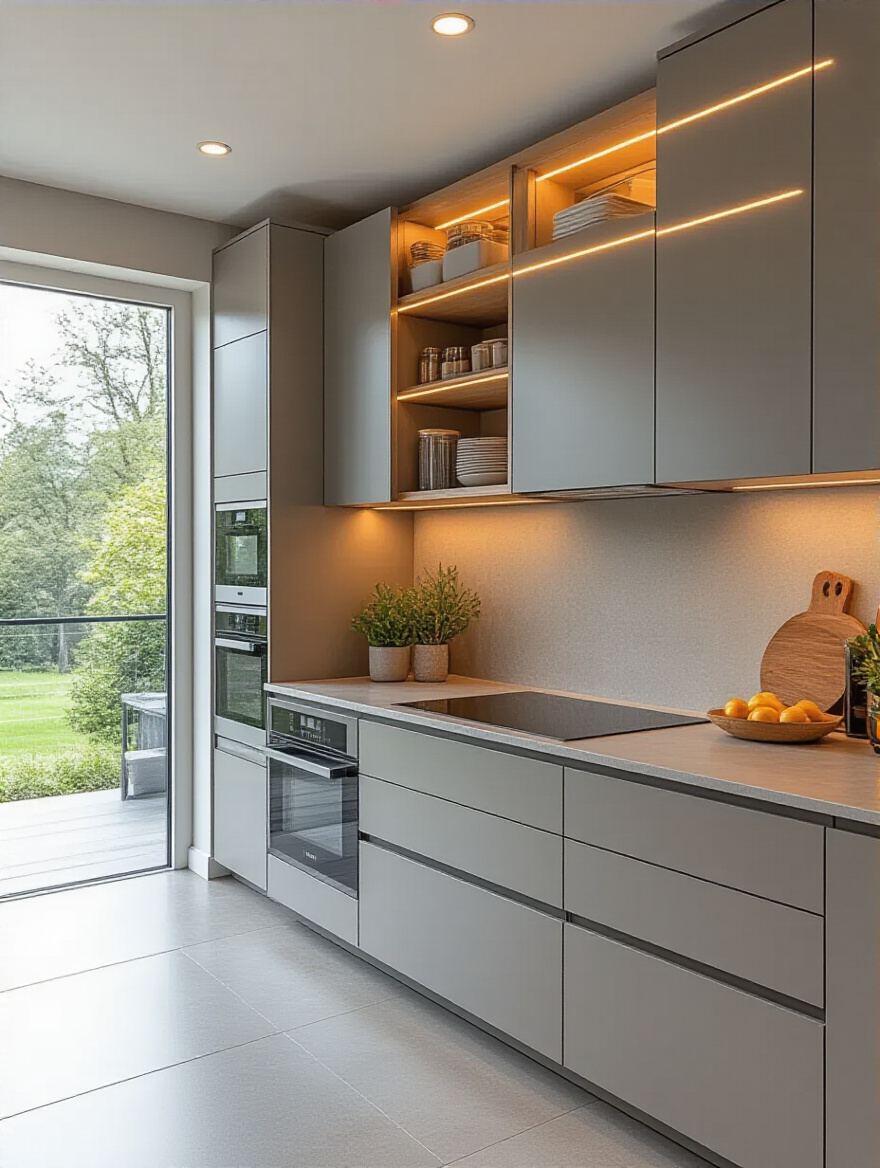
Deep drawers with custom dividers are another game-changer. They are far more ergonomic and accessible than deep lower cabinets, especially for older adults, as you can see everything from above without having to bend down and dig around. I once reorganized a tiny galley kitchen just by swapping the lower cabinets for deep drawers. The client felt like she’d doubled her storage and could finally keep her countertops clear.
With clear counters, the island becomes the undisputed center stage, so its seating matters.
Bar stools are not an afterthought! They are a key opportunity to inject personality, color, and texture. They anchor the island and signal that this is a place for gathering. But you must think about who will be sitting in them.

For a family with varying needs, it’s often wise to choose a mix of seating. Maybe have a couple of backless stools that can tuck neatly under the counter and stay out of the way. But also be sure to include a few stools with comfortable backs and sturdy footrests. This is crucial for an older family member or anyone who will be sitting for a longer period of time. Comfort is key to making the island a truly inviting social hub.
Finally, the most personal touch of all.
Please, hang art in your kitchen! This is the room where you spend so much of your life; it deserves to be filled with things that make you happy. It’s the ultimate way to tell your family’s story and make the space uniquely yours. It’s what prevents a beautiful kitchen from looking like a generic showroom.

It doesn’t have to be an expensive painting. It could be a gallery wall of family photos in simple black frames. It could be a colorful textile from your family’s country of origin. It could be a large, framed print of your child’s best piece of artwork. In my own kitchen, I have a beautifully framed recipe handwritten by my grandmother. It’s my most treasured possession, and it brings her memory into the heart of my home every single day.
Creating a modern kitchen that works for a real, diverse family is an act of love. It’s a puzzle of balancing different needs, traditions, and personalities. It goes far beyond what’s trendy and gets to the heart of what a home is really for: to be a place of comfort, connection, and joy.
By focusing on a foundation of calm, a layout that supports everyone, and materials that are both beautiful and durable, you create a stage for life to happen. A truly modern kitchen isn’t just a place to cook. It’s a place to talk, to laugh, to share, to learn, and to grow. It’s a space where every member of your family, no matter their age or ability, feels not just accommodated, but celebrated.